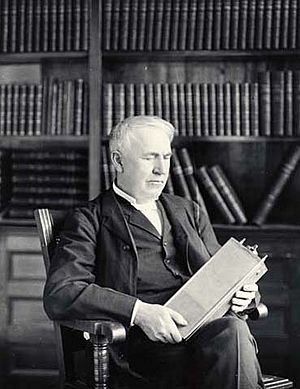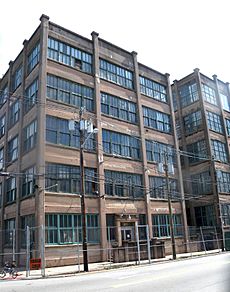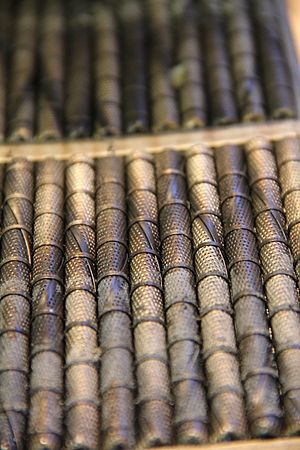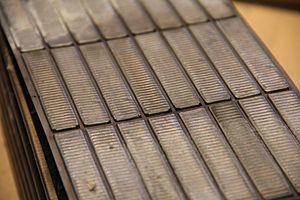Nickel–iron battery facts for kids

Nickel–iron batteries manufactured between 1972 and 1975 under the "Exide" brand originally developed in 1901 by Thomas Edison.
|
|
| Specific energy | 19-25 Wh/kg |
|---|---|
| Energy density | 30 Wh/L |
| Specific power | 100 W/kg |
| Charge/discharge efficiency | <65% |
| Energy/consumer-price | 1.5 – 6.6 Wh/US$ |
| Self-discharge rate | 20% – 30%/month |
| Time durability | 30 – 50 years |
| Cycle durability | Repeated deep discharge does not reduce life significantly. |
| Nominal cell voltage | 1.2 V |
| Charge temperature interval | min. −40 °C – max.46 °C |
A nickel–iron battery (also called a NiFe battery) is a special type of rechargeable battery. It uses plates made of nickel(III) oxide-hydroxide and iron. These plates sit in a liquid called an electrolyte, which is made of potassium hydroxide.
This battery is very strong and can handle tough conditions. It can be overcharged, overdischarged, or even short-circuited without much damage. Because it's so tough, it can last for a very long time, sometimes more than 20 years!
Even though it's durable, the nickel–iron battery isn't used as much today. This is because it doesn't store a lot of energy for its weight, loses its charge quickly, and costs a lot to make. Other types of rechargeable batteries have become more popular for most uses.
Contents
What are NiFe Batteries Used For?
Nickel–iron batteries have been used in many important ways.
Powering Trains and Subways
Many railway vehicles, like some London underground electric locomotives and New York City Subway cars, use NiFe batteries. They are great for backup power in these systems.
Off-Grid Energy Solutions
These batteries are becoming popular again for homes and systems that are "off-the-grid". This means they are not connected to a main power supply. Since these systems are charged daily, the NiFe battery's ability to handle frequent charging makes it a good choice.
Future Fuel for Cars
Scientists are looking into using nickel–iron batteries in a new way. They could work as both a battery and a device that makes hydrogen gas. This process is called electrolysis. These special batteries, sometimes called "battolysers," could power fuel cell cars. They would charge like normal batteries and produce hydrogen when fully charged.
How Durable are NiFe Batteries?
These batteries can handle many charge and discharge cycles. This is because the chemicals inside them don't dissolve much in the electrolyte. When the battery charges, new iron forms slowly. This slow process helps protect the battery's parts, making them last longer.
However, this slow process also means the batteries charge and discharge slowly. They are not good for devices that need a lot of power very quickly. Also, you can't charge nickel–iron cells with a constant voltage. If you do, they can get too hot and be damaged. This is called "thermal runaway."
How NiFe Batteries Work
When a nickel–iron battery works, oxygen moves from one side to the other. This is why it's sometimes called an "oxygenlift cell."
When the battery is fully charged, the positive plates have a lot of oxygen. The negative plates are in a "reduced" state, meaning they have less oxygen. As the battery discharges, oxygen moves from the positive plates to the negative plates. This causes the negative plates to gain oxygen.
The battery usually has an open-circuit voltage of 1.4 volts. This drops to about 1.2 volts when it's discharging. The liquid electrolyte, made of potassium hydroxide and lithium hydroxide, doesn't get used up during charging or discharging. This is different from a lead-acid battery, where the liquid changes as the battery works. Adding lithium hydroxide helps the battery work even better.
The History of NiFe Batteries
Early Inventions
The idea for nickel-based batteries started with Swedish inventor Waldemar Jungner. In 1899, he invented the nickel–cadmium battery. Jungner also tried using iron instead of cadmium. He found that iron batteries were cheaper, but they didn't charge as well and produced more hydrogen gas. Because of this, he didn't focus on the nickel–iron design.
Edison's Contribution
In 1901, the famous American inventor Thomas Edison also patented and started selling nickel–iron batteries in the United States. He hoped they would power electric vehicles, which were popular in the early 1900s. Edison believed his design was much better than the lead-acid batteries used at the time.
Edison's batteries could store more energy and charge faster than lead-acid ones. However, they didn't work well in cold weather and were more expensive. Electric vehicles eventually became less popular, which disappointed Edison.
Later Uses
Jungner's work on nickel-cadmium batteries wasn't well known in the U.S. until the 1940s. During World War II, a 50-volt nickel–iron battery was used as the main power source for the German V-2 rocket. A smaller version was also used in the V-1 flying bomb.
Edison's company, the Edison Storage Battery Company, made these batteries profitably from about 1903 to 1972. They were sold to the Exide Battery Corporation in 1972, which stopped making them in 1975. For many years, these batteries were widely used for things like railroad signals, forklifts, and standby power systems.
Today, many of the original companies no longer make nickel–iron cells. However, new companies in different countries have started producing them again.
How the Original Edison Battery Plates Were Made
The parts of the battery that store energy are called "active materials." These materials are held inside special tubes or pockets. These tubes and pockets are attached to a metal frame, which helps conduct electricity. All the metal parts inside the battery are coated with nickel to stop them from rusting.
Positive Plates
The positive plates use a material called nickel hydrate. This material is packed into thin, perforated steel tubes, about 4 inches long. Inside these tubes, thin layers of nickel hydrate and pure flake nickel are stacked one after another. There can be hundreds of these layers! The flake nickel helps electricity flow better between the nickel hydrate and the tubes. Once filled, these tubes are placed vertically into the metal frames.
Negative Plates
The negative plates use iron oxide as their active material. This iron oxide powder is tightly packed into small, flat, rectangular pockets made of perforated, nickel-plated steel. These pockets are then attached to the metal frames. After they are mounted, they are pressed to make sure they are in close contact with the frames.
Charging a NiFe Battery
When you charge a NiFe battery, oxygen moves from one set of plates to the other. This process makes the positive plates "superoxidized" (meaning they gain oxygen) and the negative plates "reduced" (meaning they lose oxygen).
If you need to charge the battery faster, you can give it short bursts of higher current. This is okay as long as the battery doesn't get too hot (above 115˚ F / 46˚ C). These quick charges work well and don't harm the battery. You can even use currents up to three times the normal charging rate for about 30 minutes.
To fully charge a NiFe cell, it usually takes about seven hours at the normal charging rate. How long you charge it depends on how much it was used before. For example, if the battery is half-empty, you would charge it for about 3.5 hours. Charging it more than needed wastes electricity and makes the water in the electrolyte evaporate faster.
Discharging a NiFe Battery
When a NiFe battery discharges, the positive plates lose oxygen. This oxygen then moves to the negative plates, causing them to gain oxygen.
You can continuously discharge the battery at a rate up to 25% above normal. For short times, you can even discharge it at up to six times the normal rate. If you discharge it faster than this, the voltage will drop more than usual.
The Electrolyte
The electrolyte liquid in a NiFe battery doesn't get used up in the chemical reactions. It acts like a path for electricity to flow. Its specific gravity (how dense it is) doesn't change during charging or discharging, except for changes due to water evaporating or temperature shifts. Small changes in the specific gravity are fine and only slightly affect how well the battery works.
Environmental Impact
Nickel–iron batteries are a good choice for the environment. They do not contain lead or cadmium, which are found in lead-acid and nickel-cadmium batteries. Lead and cadmium are considered hazardous materials and need special handling. Also, since the electrolyte in a NiFe battery is not an acid, there's no risk of harmful acid spills.
See also
 In Spanish: Batería de níquel-hierro para niños
In Spanish: Batería de níquel-hierro para niños
- List of battery types
- List of battery sizes
- Comparison of battery types
- Nickel–zinc battery





